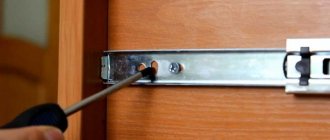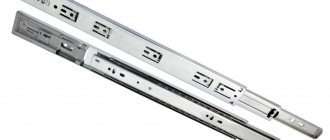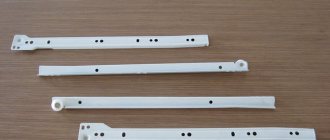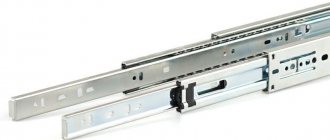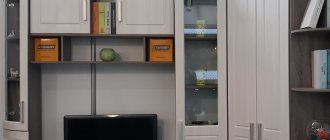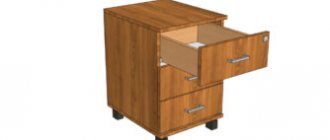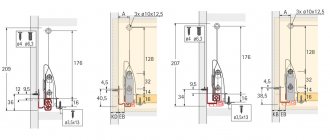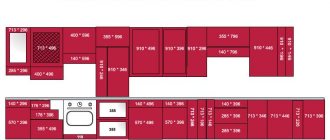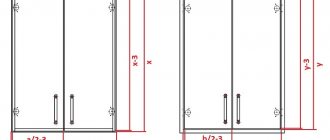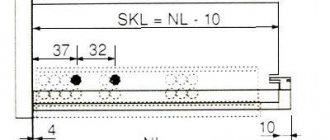Installing a cabinet is not an easy task, especially when you don’t know how and where to install some of the components for this piece of furniture. Auxiliary parts can be, for example, ball guides for drawers.
Not everyone knows how to install them, but in the meantime, without them it will not be possible to create a full-fledged place for storing clothes and any other accessories. In this material we will talk in detail about what parts the ball guide mechanism consists of, and how to install these components in the place intended for them.
Ball guides for drawers: how to install
Ball guide design: highlights
So, in order to understand the operating principle of the components we install, it is necessary to turn to their most simplified version - two-section non-separable guides. These parts consist of two rails, which:
- vary in size;
- have the shape of the letter “P”;
- are located one inside the other.
The operation of this element of the system, which is responsible for drawing out the drawers, is carried out due to the mutual movement of tracks made of steel relative to each other, which, in fact, make up the part that interests us. They are also called telescopic because of the way they fold.
Installing ball guides for drawers does not take much time
Between these tracks, as a rule, in the upper and lower parts, there are small balls. They are similar to the same balls that are usually placed in a bearing.
The element responsible for maintaining the structure as a single whole is the outer rail segment. It plays the role of a limiter, preventing the device from moving the drawer further and damaging the weight of the piece of furniture.
Existing types of ball guides
The system we are considering today, which comes as a component for home furniture, can take various forms. So, they will vary due to the original purpose of this motor system, and the set of functions with which it was originally endowed. In the table below, let's study what ball guides can be and by what criteria they are distinguished.
There are many types of ball guides
Table 1. Types of ball guides
| Criterion | Description of species |
| Possibility to disassemble the device | According to this criterion we can distinguish:
|
| Number of "steps" | Based on this parameter, we can divide existing types of guides of the type we are interested in into:
|
| Construction type | According to the item you are looking for, ball guides can be distinguished:
|
| Device installation method | Installation of the parts we are interested in can be carried out in two ways:
|
A box with such guides moves almost silently and can withstand considerable weight
The final cost of mechanisms that cannot be disassembled after installation without losing functionality will be much less than the same value for dismountable mechanisms. The fact is that the latter are produced using sophisticated technology, and are ultimately equipped with specially reinforced balls, which allow the device to be disassembled and reassembled several times without damage or fear of losing small structural elements.
The balls inside the device are made of steel. They move along the internal space of the metal profile, allowing you to easily pull out drawers made of absolutely any material and of any size from a closet, chest of drawers, beds and other pieces of furniture.
These guides are suitable for installation on drawers made of almost any material.
The final cost of these propulsion systems will be influenced by any of the parameters listed above in the table, not just the possibility of disassembly. So, the more pure stages and the number of levels with which the desired system is equipped, the more expensive it will become. This is due, of course, to the difficulties that the manufacturer had to go through when creating the device we are interested in.
Let's sum it up
You should choose one or another type of retractable fittings based on the design features of the furniture and your personal preferences. At the same time, if you want to get a durable mechanism, then you should not save money on its purchase, because low-quality guides quickly jam and stop functioning. The best option today is a telescopic system, and the installation of such fittings can be done without the help of a specialist - you just need to have all the necessary tools and fasteners on hand.
The role of ball guides in furniture production
Despite the fact that the principle of operation of telescopic devices is used to create many products in various fields of scientific and practical human activity, they most often continue to be used in the production of cabinet furniture of various types.
Ball guides are needed to equip furniture with them, which then becomes much more functional, and in addition:
- allows drawers to slide out silently;
- increases the permissible load, which has a direct impact on the box, extending its service life.
Scheme for installing ball guides in a drawer and a box underneath it.
So, as an example, we can cite wardrobes, inside of which multiple drawers are installed, saving free space and generally increasing the usability of this piece of furniture. Usually such drawers are filled with clothes and accessories, as they say, to capacity. And yet, thanks to ball guides, they work silently and accurately.
By installing ball-type guides into your piece of furniture, you will increase the service life of the furnishings equipped with them, as well as increase the convenience and efficiency of using the furniture.
Specific installation calculations will depend on the parameters of the box and fasteners selected for it
Features of fasteners
The slats can be secured in two ways: in the central part of the side outer walls of the sliding element and along their lower edge. The first option is used for large pieces of furniture, as it ensures uniform load and increases service life.
Fixation along the bottom edge is used mainly for roller runners. Ball-type ones can also be installed this way, but it is more difficult. But it is easier to adjust their position if errors were made during installation.
Ball guides for drawers: selection of parts
The set of components we are interested in consists of:
- left telescopic skid;
- right telescopic skid.
Each of the mentioned runners is also divided into two component segments.
Please note: do not assume that ball bearings can only be installed on commercially manufactured furniture. No, in fact, they can be installed on furniture made by yourself, but you will first need to find out its parameters and purchase suitable parts according to them. The fact is that the guides differ from each other in many different parameters, among which thickness is of particular importance.
Each parameter of the components must be selected by carefully measuring the piece of furniture being assembled.
The depth of the drawer on which installation will be carried out must be equal to the length of the part we select, however, we must take into account that between the back wall of the piece of furniture being equipped and the back wall of the drawer, When installing guides, it is necessary to leave a minimum gap of 1 centimeter.
Also, when selecting guides, it is necessary to take into account the thickness:
- the retractable mechanism itself;
- the outer walls of our box.
In addition, do not forget about adding a technological gap that compensates for the inaccuracies you made when measuring. Using this gap will subsequently provide the drawers with completely free movement. Most often, the value of this technological parameter is approximately a millimeter.
Adjustment of drawers using this type of guides is carried out in two planes
The width of the drawer is calculated by subtracting the following double values:
- thickness of the outer part of the walls;
- the thickness of the mechanism itself;
- the size of the gap left.
The same parameter as the length of the box will be limited by the free space at our disposal. However, it is much easier to calculate it, because all you need to do is reduce the free space by the size of the next gap.
In order to carry out the measurements we need, we will first have to install the drawer in the cabinet box according to all the rules, and then we will be able to adjust it, make the markings correctly, and subsequently properly hang the guides.
Telescopic guides for drawers are modern fittings that allow you to effortlessly open even massive structures. Would you like to learn in detail about the installation of telescopic guides and the correct calculation for their installation? Read the special article.
Video - Ball guides. Installation
What you need for installation
Now to the question of how to install ball guides for drawers.
To install the runners that will guide and open the drawer completely, you will need to arm yourself with:
- pencil;
- tape measure or long ruler;
- level;
- screwdriver or screwdriver;
- awl (optional);
- drill and thin drill bit.
If installation is planned on a wooden structure, then it is better to pre-drill the holes for the self-tapping screws with a thin drill. This will prevent the wood from cracking.
For ordinary furniture made of chipboard and MDF, such manipulations are usually not required. Just carefully screw in the screws. You can first make a precise and small recess using an awl.
Now you can install. The installation scheme itself is not particularly complicated, but it requires accuracy, attentiveness, and a sequence of actions.
Ball guides
How to install ball guides on drawers with your own hands
So, we have come to the moment for which, in fact, you were looking for this article. It involves learning how to independently install ball guides on drawers for a cabinet or other piece of furniture. So let's get started.
Drawer on ball guides
Step No. 1 – make markings for fittings
So, first of all, you need to make markings for the fittings being installed. It is done using a pencil and a ruler, since we need to mark the axis passing strictly through the central part of the box.
First of all, we need to draw an axis under the guide
After this stage is completed, we move on to the next one.
Step No. 2 – Attach the component runner to the marked side of the drawers
So, we have drawn the axis along which the parts will be installed. Now you need to place a guide rail on it so that the front edge of this part is flush with the façade of the furniture segment being equipped. However, you need to carefully ensure that the part does not bulge forward, since in this situation it is quite possible that a gap will appear, which we do not need at all.
Pay attention to the runner. The regulating holes cut on it will help us place it correctly. They are small and oblong.
The required adjustment holes are needed in order to correctly secure the runner relative to the box.
Using the discovered holes, we align our runner strictly along the marked axis. This is easy to do: just line up all the holes with a line so that it clearly runs through their center.
Then we insert a self-tapping screw into the hole located horizontally on our part. Now we can move the runner back and forth without changing the position of its segment.
Adjustment hole responsible for the direction of movement up and down on the back of the drawer
We secure the rear segment of our runner through the gap responsible for the movement of the box along the vertical axes. This will be necessary in order to subsequently be able to adjust the height of the box by following the next few simple steps.
- Using a screwdriver or screwdriver, remove the self-tapping screw from the front hole, which is responsible for the horizontal movement of the box.
- We will re-screw the same self-tapping screw, however, into the front hole, which is responsible for the movement of the box along the vertical axis.
Duplicate adjustment hole for the “up and down” direction, for the front segment of the cabinet part being equipped.
Then we get that the part will subsequently be attached to the drawer by means of two adjustable holes located both in the front and in the back of the drawer, responsible for movement it along the “up-down” axis.
Step No. 3 - installing the guide directly to the side of the box
Now, in order for our device to work and the drawers to slide out, it is necessary to attach the second part of our guide system to the inside of the cabinet box, inside which the drawer is then installed.
The mounting hole, inside of which a self-tapping screw is placed, is of the most common type, round
Only here you need to take into account one important point: unlike the segment of the guide system that attaches to the side of our drawer, the part that goes into the box has much more adjustable holes. And in addition to the gaps through which the system can move along the axes of interest to us “up and down” and “forward and backward,” they also have other grooves of the horizontal and vertical type, into which screws also need to be screwed.
Mounting hole and adjustment grooves, the presence of which must be taken into account when installing this part of the guides
Attach the guide and adjust it, thus inserting screws as in the previous step into only two holes so that the box fits inside the correct box. Once you are sure that everything is installed and adjusted as intended, remove the boxes again and screw the screws into all the holes of the box parts.
Manufacturing materials
Guides for sliding doors are made from the following materials:
- Steel - it makes quite strong structures, but you need to choose the right profile size relative to the weight of the facade. Steel guides for wardrobe doors belong to the middle price segment, however, the cost of products from some brands is overpriced relative to the technical characteristics of the product.
- Plastic - this type of raw material is considered the least reliable. Plastic products are characterized by low cost and poor quality. They are suitable only for light, small facades. Today, combined rails are more often used, where a plastic profile provides an iron supporting surface for the wheels.
- Aluminum - the most durable profiles are made from it. They have the best features in terms of quality. It is allowed to install door leaves up to 4 m high and of any weight on them. Another advantage is the ability to choose a suitable design. The only disadvantage of the material is its high cost.
Metal profiles can be painted in two ways:
- Anodizing is the application of color using a chemical method; during the painting process, the pigment penetrates into the metal. This coating is durable, resistant to high humidity and sunlight.
- Applying PVC film - this method of painting is also considered quite wear-resistant. The presence of an external coating contributes to the silent opening of doors.
The color coating of guides and handle profiles can be not only monochromatic. Consumers are offered imitation of the texture of wood or stone, painting with an aging effect, patination.
Steel
Plastic
Aluminum
Anodizing
PVC film
